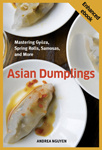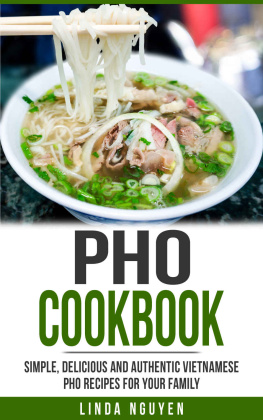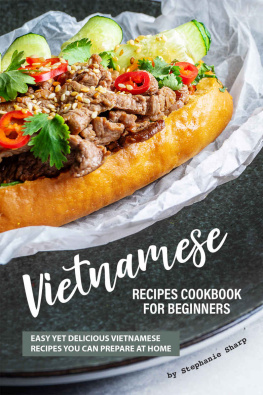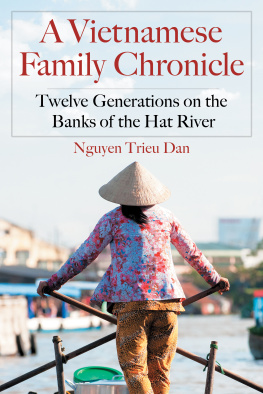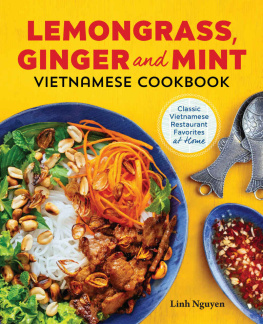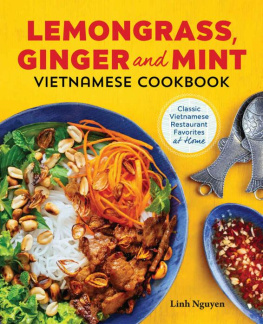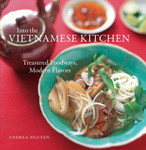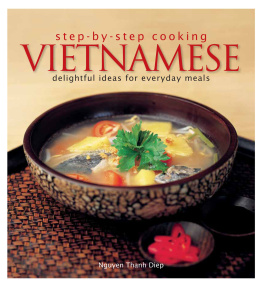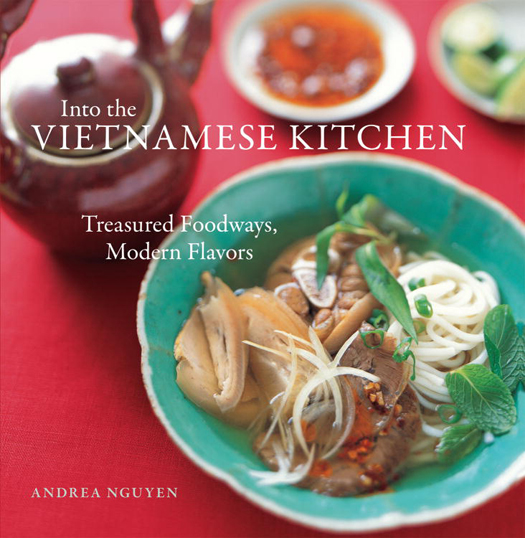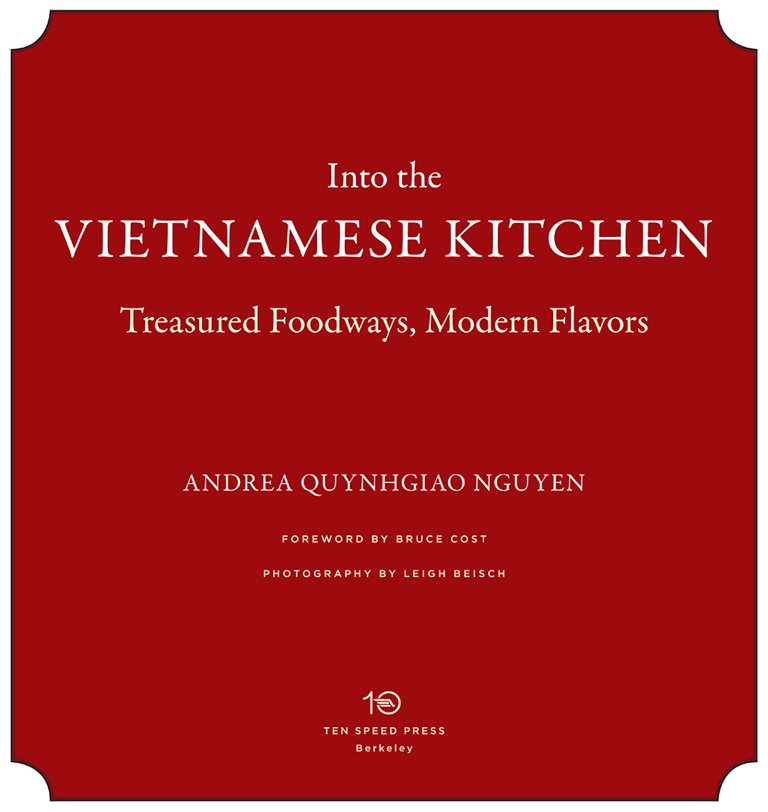Copyright 2006 by Andrea Quynhgiao Nguyen
Foreword copyright 2006 by Bruce Cost
Photography copyright 2006 by Leigh Beisch
All rights reserved. Published in the United States by Ten Speed Press, an imprint of the Crown Publishing Group, a division of Random House, Inc., New York.
www.crownpublishing.com
www.tenspeed.com
Ten Speed Press and the Ten Speed Press colophon are registered trademarks of Random House, Inc.
Library of Congress Cataloging-in-Publication Data
Nguyen, Andrea Quynhgiao.
Into the Vietnamese kitchen : treasured foodways, modern flavors / Andrea Quynhgiao Nguyen; foreword by Bruce Cost; photography by Leigh Beisch.
p. cm.
Includes bibliographical references and index.
1. Cookery, Vietnamese. 2. Food habits-Vietnam. I. Title.
TX724.5.V5N47 2006
641.59597-dc22
2006012158
eISBN: 978-1-60774-141-1
Cover design by Toni Tajima
Food styling by Karen Shinto
Prop styling by Sara Slavin
Photography assistance by Angelica Cao
Styling assistance by Katie Christ
v3.1
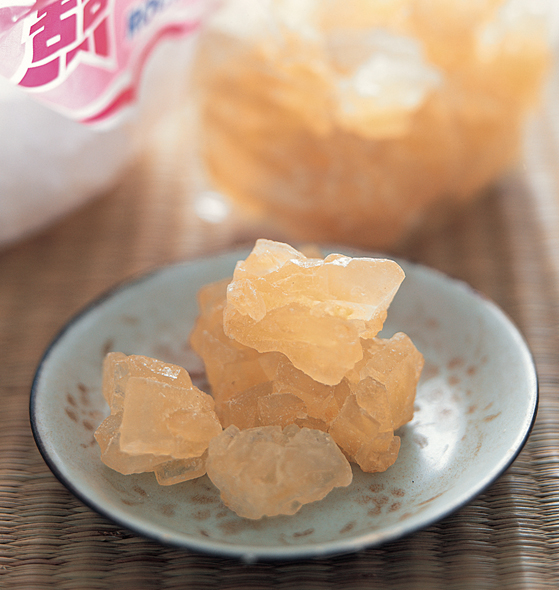
To my parents, Tuyet Thi Nguyen and Hoang Quoc Nguyen, and my husband, Rory.
CONTENTS
ACKNOWLEDGMENTS
I have wanted to write a Vietnamese cookbook since I was ten years old. When I was offered the opportunity to do just that, I discovered both how much and how little I knew. Many people assisted me along the way, and I am indebted to all of them for their guidance and support.
First and foremost, I want to thank M and B, who sparked and then fueled my interest in food, cooking, and Vietnamese traditions. How lucky I am to have parents who are also passionate food experts. As I wrote, they tirelessly answered my questions, shared their knowledge and discoveries, helped with translations, and reviewed the manuscript. When they did not know the answers, they tapped their network of Vietnamese retirees.
A number of recipes and cooking tips were shared by family members and friends over the years. These contributions are recognized in the recipe introductions.
Special thanks to Susan Littwin for believing in this project from its inception. She helped me polish the proposal and guided me with her wisdom as a seasoned author.
I am equally grateful to recipe testers Sue Holt, Victor Fong, Al Meyers, Maki Tsuzuki, and Mike Crane. Their steadfast dedication and enthusiasm kept me on track and buoyed me when my spirits flagged.
I was also blessed by the insights of Asian food expert Bruce Cost. Our lengthy e-mail exchanges helped me to solve a variety of vexing issues.
Most Vietnamese immigrants in the United States do not become food writers. Asian parents prefer that their children follow practical and profitable career paths. My parents were no different, but they also instilled in me a love and appreciation for the culinary arts. I started out in banking and went on to a handful of other careers, but this one has been the most fun and the most rewarding. I would have never pursued this book project had it not been for the following individuals: Colman Andrews, who invited me to write for Saveur magazine and saw the potential in this endeavor; Russ Parsons and Leslie Brenner, who accepted my ideas and edited my work for the Los Angeles Times; and Carolyn Jung, who started me writing for the San Jose Mercury News and encouraged me to continue writing. These journalists, along with their colleagues, helped me hone my writing skills and steered me in the right direction. Although our interactions were sometimes fleeting, I owe each one of them a great deal.
Generous thanks are owed to Mishka Michon for her early enthusiastic support of this book. At the University of Southern California, Professor Michael Preston mentored me with his practical and sage advice.
These pages would not have materialized without the folks at Ten Speed Press, in particular, Philip Wood, Lorena Jones, Kathy Hashimoto, and Aaron Wehner, my enthusiastic and thoughtful editor. They all believed that I had something valuable to say. My words benefited from the professional excellence of copy editor Sharon Silva and proofreader Desne Ahlers; photographer Leigh Beisch, assisted by Angelica Cao; food stylist Karen Shinto, assisted by Katie Christ; prop stylist Sara Slavin (and the generous loan of props by Sue Fisher King); designers Ed Anderson, Toni Tajima, and Katy Brown; and indexer Ken DellaPenta.
A zillion thank-yous to William Rubel and Sonia Bauelos for cracking open the door.
My dear husband, Rory OBrien, has always been and continues to be my number one fan. He has suffered, celebrated, critiqued, and smiled through this entire journey. His patience, understanding, and love are amazing.
Finally, generous thanks go to Internet visitors like Karl Nguyen who have perused the content of vietworldkitchen.com and e-mailed comments. Their insights and feedback inform and improve my work.
FOREWORD
Andrea Nguyen has taken a big step forward on behalf of Vietnamese cooking. She has written a cookbook that you can use and enjoy, layered with detailspractical, historical, and personalthat foster a deeper understanding of this ancient cuisine.
You need only turn to her recipe for ph b, Vietnams famed beef noodle soup, to appreciate her achievement. She wants you to love this soup, but in order for you to do so, she insists that you must make it right, a process that begins (and ends) with the broth. This requires using high-quality marrow bones, to impart a rich beef flavor, and a little yellow rock sugar (also used in the wonderful braised pork and duck dishes of eastern China), to lend complexity that mere granulated sugar lacks. When Andrea introduces a recipe by writing, Traditional cooks use extra lard or oil to give the shrimp, which are still in the shell, an appetizing sheen, she is giving the reader an important option: follow her recipe, which is delicious, or seek even greater insight into the cuisine by rendering your own pork fat and sourcing head-on, or even live, shrimp.
I have gotten to know Andrea over the past couple of years, mostly through lengthy correspondence about arcane aspects of Asian food and cooking. She has taken me shopping and eating in Little Saigon in Westminster, California, and she directed several of my top chefs in Chicago in the preparation of an array of classic dishes from this book. I felt a kinship with her in her search here for a whole catfish, with skin, because the gelatin is necessary to give proper body to her caramel sauce. Her technique of cooking shrimp in a little water and salt until dry, and then mincing them as a garnish for steamed rice pancakes, was new to me. Capturing the essence of their flavor, the method transformed the shrimp into a terrific seasoning.
Andreas book is timely because Vietnam is rapidly becoming a tourist destination for Americans after years of isolation following the Vietnam War. I had the opportunity to travel in Vietnam last summer with my teenage son, Ben, eating and visiting markets. What struck us (and this is true elsewhere in Asia) is that the freshness of the ingredients drives the cuisine, as Andrea so often reminds us. When entering a seafood restaurant on the coast south of Nha Trang, rather than looking at a menu, our first task was to peruse tanks of swimming fish and crustaceans both familiar and unfamiliar, such as mantis shrimp and slipper lobsters. After deliberating with the restaurant staff over how each should be cooked, our table was loaded with the tastiest possible sea creatures and an array of delicious dipping sauces and fresh herbs. Andreas book vividly evoked this memory for me, and should I care to re-create the feast, she equips me with the necessary recipes and insights.



